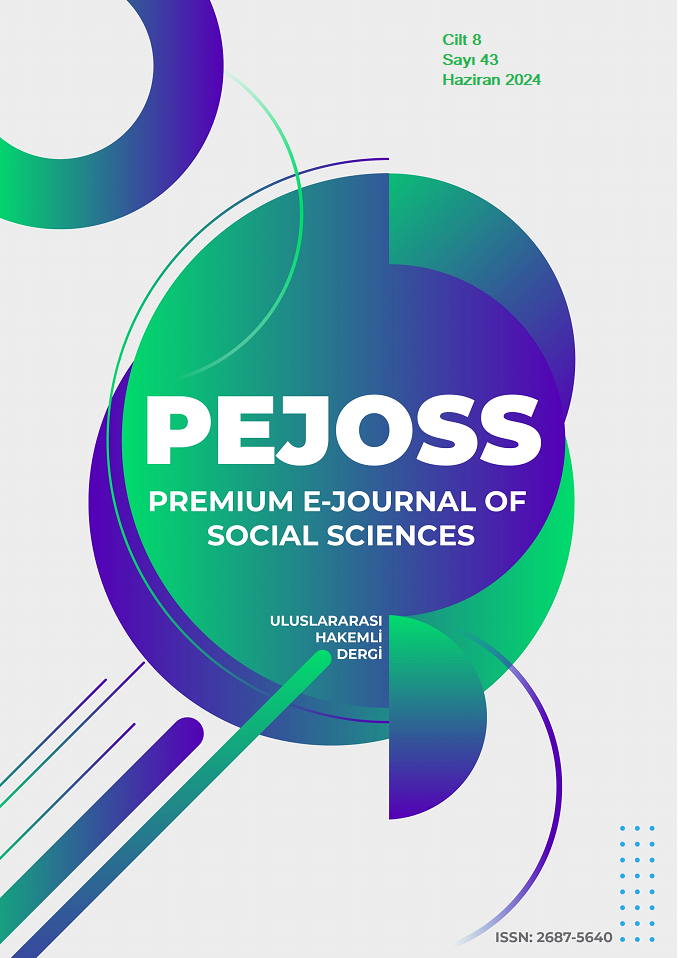Teachers' Digital Competences as A Matter of Concern
DOI:
https://doi.org/10.5281/zenodo.12603675Keywords:
teacher digital efficacy, educational technology, professional anxietyAbstract
Educational technology is a tool used in classrooms to enrich the learning experience and enable students to learn more effectively. However, teachers' anxiety about using these technologies is one of the obstacles to successful integration. In this study, the relationship between teachers' digital competencies and their anxiety about using educational technology was analysed. The research was conducted in a relational survey model with a quantitative research method. 316 classroom teachers were included in the study. A Stratified sampling method was used in the selection of teachers. The Digital Teacher Scale was used to determine teachers' digital competencies and the Educational Technology Use Anxiety Scale was used to determine the anxiety arising from educational technologies. The results of the study showed that there was a high level of negative relationship between teachers' digital competencies and their anxiety about using educational technology. Another finding of the study shows that teachers' digital competencies differ in all sub-dimensions according to gender and occupational variables. Similarly, while teachers' concerns about using educational technology differ according to gender and professional seniority variables, they do not differ according to the place of duty variable.
Downloads
References
Anderson, R. E., & Dexter, S. L. (2005). School technology leadership: An empirical investigation of prevalence and effect. Educational Administration Quarterly, 41(1), 49-82. https://doi.org/10.1177/0013161X04269517
Baş, G., Kubiatko, M., & Sünbül, A. M. (2016). Teachers’ perceptions towards ICTs in teaching-learning process: Scale validity and reliability study. Computers in Human Behavior, 61, 176-185.
Bingimlas, K. A. (2009). Barriers to the successful integration of ICT in teaching and learning environments: A review of the literature. Eurasia Journal of Mathematics, Science and Technology Education, 5(3), 235-245. https://doi.org/10.12973/ejmste/75275
Büyüköztürk, Ş., Çakmak-Kılıç, E., Akgün, Ö. E., Karadeniz, Ş., ve Demirel, F. (2013). Bilimsel araştırma yöntemleri. Ankara: Pegem Akademi
Creswell, J. W. (2017). Araştırma deseni: Nicel, nitel ve karma yöntem yaklaşımları (Çev. Ed. S. B. Demir). Ankara: Eğiten Kitap.
Çakıroğlu, Ü. & Akay, H. (2019). Öğretmenlerin dijital yeterlilikleri: Bir değerlendirme. Eğitim ve Bilim Dergisi, 44(198), 35-52.
Ertmer, P. A., & Ottenbreit-Leftwich, A. T. (2010). Teacher technology change: How knowledge, confidence, beliefs, and culture intersect. Journal of Research on Technology in Education, 42(3), 255-284. https://doi.org/10.1080/15391523.2010.10782551
European Commission (2018). European Framework for the Digital Competence of Educators (DigCompEdu). Publications Office of the European Union.
Fraenkel, J. R., Wallen, N. E., ve Hyun, H. H. (2012). How to design and evaluate research in education (7th Ed.). New York: McGraw-Hill.
Hauge, T. E., & Norenes, S. O. (2015). Collaborative leadership development with ICT: Experiences from three exemplary schools. Journal of Computer Assisted Learning, 31(2), 183-195.
Hew, K. F., & Brush, T. (2007). Integrating technology into K-12 teaching and learning: Current knowledge gaps and recommendations for future research. Educational Technology Research and Development, 55(3), 223-252. https://doi.org/10.1007/s11423-006-9022-5
Inan, F. A., & Lowther, D. L. (2010). Factors affecting technology integration in K-12 classrooms: A path model. Educational Technology Research and Development, 58(2), 137-154. https://doi.org/10.1007/s11423-009-9132-y
Kim, C., Kim, M. K., Lee, C., Spector, J. M., & DeMeester, K. (2013). Teacher beliefs and technology integration. Teaching and Teacher Education, 29, 76-85. https://doi.org/10.1016/j.tate.2012.08.005
Koehler, M. J., Mishra, P., & Cain, W. (2013). What is technological pedagogical content knowledge (TPACK) Journal of Education, 193(3), 13-19.
Kopcha, T. J. (2012). Teachers’ perceptions of the barriers to technology integration and practices with technology under situated professional development. Computers & Education, 59(4), 1109-1121.
Li, Y., Worch, E. A., Zhou, Y., & Aguiton, R. (2015). How and why digital generational characteristics affect technology adoption and teaching methods: Insight from a China study. International Journal of Information and Education Technology, 5(7), 547-551.
Sang, G., Valcke, M., van Braak, J., & Tondeur, J. (2010). Student teachers’ thinking processes and ICT integration: Predictors of prospective teaching behaviors with educational technology. Computers & Education, 54(1), 103-112.
Tondeur, J., Aesaert, K., Pynoo, B., van Braak, J., & Fraeyman, N. (2017). Developing a validated instrument to measure pre-service teachers' ICT competencies: Meeting the demands of the 21st century. British Journal of Educational Technology, 48(2), 462-472.
Tondeur, J., Valcke, M., & van Braak, J. (2008). A multidimensional approach to determinants of computer use in primary education: Teacher and school characteristics. Journal of Computer Assisted Learning, 24(6), 494-506. https://doi.org/10.1111/j.1365-2729.2008.00285.x
Tondeur, J., van Braak, J., Ertmer, P. A., & Ottenbreit-Leftwich, A. (2017). Understanding the relationship between teachers’ pedagogical beliefs and technology use in education: A systematic review of qualitative evidence. Educational Technology Research and Development, 65(3), 555-575.
Vrasidas, C., & Glass, G. V. (2007). Teacher professional development and ICT: Strategies and models. Teachers College Record, 109(14), 87-102.
Yalçınalp, S., & Cabı, E. (2015). A scale development study: educational technologies anxiety scale (ETAS). Elementary Education Online, 14(3), 1005-1016.
Yılmaz, E., Aktürk, A., & Çapuk, S. (2021). Dijital öğretmen yeterlilik ölçeği geliştirme: geçerlik ve güvenirlik çalışması. Adıyaman Üniversitesi Sosyal Bilimler Enstitüsü Dergisi, (38), 34-68.
Downloads
Published
How to Cite
Issue
Section
License
Copyright (c) 2024 Premium e-Journal of Social Science (PEJOSS)

This work is licensed under a Creative Commons Attribution 4.0 International License.


